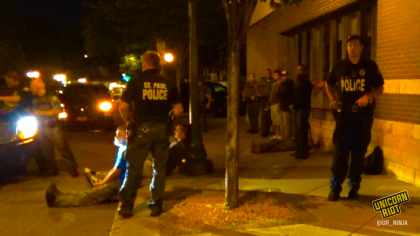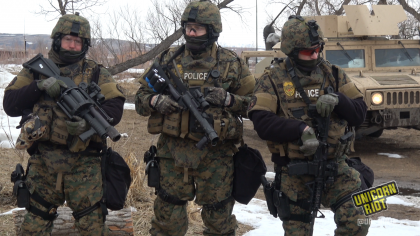First Vaughn Prison Revolt Trial Begins
Wilmington, DE – On February 1, 2017, a prisoner uprising took place at the James T. Vaughn Correctional Center in Smyrna, Delaware. Over 100 inmates at the maximum security prison seized control of ‘Building C’ at the state Department of Corrections complex, taking several prison employees hostage in an uprising that would last almost 24 hours. Those involved in the uprising demanded better living conditions, access to education, transparency in use of prison funds, and an end to inconsistent enforcement of prison policies. Now, more than a year and a half after the historic uprising, four defendants – Jarreau Ayers, Derric Forney, Dwayne Staats, and Roman Shankaras – are the first to face trial after refusing plea deals offered by prosecutors.
After police retook Building C on February 2, 2017, 18 prisoners were eventually indicted on felony counts of riot, conspiracy, first degree kidnapping, first degree assault, and first degree murder. Since one of the 18 – Royal ‘Diamond’ Downs – has turned state’s evidence, supporters are referring to the Vaughn uprising defendants as the “Smyrna 17” (The James T. Vaughn Correctional Center is in Smyrna, Delaware.) Apart from Ayers, Forney, Staats, and Shankaras, four other groups of prisoners face trials in between November 2018 and February 2019.
All four defendants seemed confident and prepared in court, sitting upright and paying close attention during opening arguments on Monday. Ayers and Staats are both representing themselves pro se and appeared eager to finally confront the charges against them. The four defendants, all black men, were closely guarded in the courtroom at all times by at least 9 Delaware Department of Corrections officers, all of whom appeared to be white.
18 jurors – 3 white men, 10 white women, 3 black men, & 2 black women – were seated around 10 AM in Judge William Carpenter’s courtroom on the 8th floor of the Leonard C Williams Justice Center. After the jurors were sworn in, opening arguments for the state of Delaware were made by Assistant Attorney General Nichole Warner. Warner called February 1, 2017, “a day unlike any other” and told jurors that “suddenly and violently, a group of inmates took the building over.”
In language echoing the failed federal rioting conspiracy case against protesters arrested at Trump’s inauguration, Assistant Attorney General Nichole Warner told jurors that prisoners who may have only intended to organize civil disobedience in their facility were still ultimately responsible for the death of Corrections Officer Steven Floyd:
“All people associated with the original crime can be held liable…even if there was no agreement [to commit murder].” – Assistant Delaware Attorney General Nichole Warner
Assistant Attorney General Warner’s opening argument primarily focused on building the basic narrative of events that will be referred to by witnesses throughout the trial. She described how on February 1, 2017, when corrections officers (COs) called for inmates to come inside from the recreation yard to take showers, several masked prisoners attacked the COs with a mop wringer, subduing them and taking them hostage, restraining them with their own handcuffs.
Sergeant Steven Floyd, who would later be killed, was known to be verbally abusive towards inmates, according to defense lawyer Jason Antoine, who said he was known for yelling at prisoners in their cells. During the takeover, Floyd was initially detained by prisoners in a mop closet, but was later moved to the Sergeant’s office, where investigators would later find his corpse.
Two other COs, Winslow Smith and Joshua Wilkinson, were also taken hostage and reportedly beaten and injured, but survived. Smith was released during hostage negotiations, while Wilkinson was kept behind and used as a go-between during the final attempted negotiations until police retook Building C. A prison counselor was also taken hostage during the standoff but was not physically harmed.
Once the prisoners had taken control of Building C, they began negotiating over the radio for the release of the hostages. The prosecution alleges that defendant Dwayne Staats threatened to kill hostages over the radio, telling police “if you breach, they will die immediately” – a claim expected to be contested by Staats as the trial proceeds. The state played an extended sample of Department of Corrections radio chatter from the negotiations, although the recording had a severe echo effect that made it difficult to understand what was said.
The state acknowledged that they had absolutely no surveillance video footage from the prison that day. Around 2 PM on the day of the uprising, the prisoners involved in the takeover agreed to let other inmates with health conditions leave the building, with more being released later at midnight. Around 5 AM, militarized police with Delaware’s Corrections Emergency Response Team (CERT) had breached building C, extracted the remaining hostages, and began subjugating the prisoners still inside the facility.
Images shown by the prosecution during opening arguments included pictures of burnt lockers, allegedly demonstrating how prisoners were burning bloody clothes to prevent them from being used as criminal evidence, and pictures of the mop wringer that was reportedly used to assault guards during the takeover.
Assistant Attorney General Warner went on to make more specific allegations against each of the defendants. Jarreau Ayers, she said, made a phone call from inside Vaughn on January 31, the day before the uprising, in which he allegedly said “something big” was going to happen soon and asked for money to be put on his commissary. The state also claimed that one of their cooperating witnesses would testify that Ayers attacked a CO and that he was seen “giving orders” during the riot. Warner mentioned defendant Derric Forney only briefly, claiming offhand that he “assaulted officers.”
Roman Shankaras was called a “mastermind” and “shot caller” although Warner also added that “he didn’t assault anyone himself.” The case against Shankaras seems to orbit around a kite (prison letter) that he wrote to another inmate, which his lawyer claims was written under duress. Dwayne Staats was also alleged to have been seen by cooperating inmate witnesses with a shank and a radio during the uprising as well as assaulting a CO and “giving orders” to other prisoners. The prosecution plans to use letters written by Staats to claim that he took responsibility for the riot and the death of Sergeant Floyd.
After Assistant Attorney General Warner finished outlining the state’s case against the defendants, each of the defendants made their opening arguments. Jason Antoine, defense counsel for Roman Shankaras, told jurors “if you had to boil this case down to one thing… this is about dignity” and argued that Shankaras and many other prisoners had simply planned to “stand out in the yard to protest prison conditions.” He also spoke about poor living conditions in Building C at Vaughn and told jurors that “this riot had been brewing” for a long time due to “mistreatment” and “inconsistent policies.” Antoine called the Vaughn Uprising “a shock to the state of Delaware and a shock to the prison system,” pointing out that it is the first time a corrections officer has been killed in a Delaware facility.
Defense counsel for Shankaras also pointed out the presence of a security camera that could have captured Shankaras’ presence in the recreation yard while the prison takeover happened inside. He says the state responded to his request for the footage by telling him that “the camera location system only works from one location at a time.”
He also named three specific “bad apple guards” – Abigail West, and Estrada Green and Lance Green – as particularly responsible for exacerbating tensions amongst prisoners inside Building C. Antoine also pointed out that Shankaras was either out of the yard or in his cell during most of the events in question, including with Sergeant Floyd was killed. He told jurors that his client was an “outlier” to the day’s events, didn’t give orders to anyone or talk on the radio, and was being charged as retaliation for not testifying against others.
Antoine spent most of his opening statement poking various holes in the testimony expected to be heard over the next few weeks from cooperating inmate witnesses. He further alleged that cooperating witnesses had been housed together by the state at Howard Young Correctional Facility so that they could rehearse their stories together. One state’s witness he brought to the jury’s attention was a convicted pedophile; another had admitted to being a compulsive liar. At one point he called the case “garbage evidence in, garbage evidence out” and went on to mention that one prosecution witness falsely claimed that Sergeant Floyd was beheaded. Another of the state’s cooperating witnesses reportedly stole Floyd’s watch off of his wrist.
Antoine seemed to relish getting to what he told jurors was the “good part” of his opening statement, telling them “Hollywood ain’t ready for this.” He was referring to Royal Diamond Downs, the state’s “star witness” who was himself a participant in the Vaughn Uprising before flipping to testify for the prosecution in exchange for dodging the murder changes. According to Antoine, Downs is “one of the most influential people in the Delaware prison system” and sat at the top of the prison hierarchy where he could order hits by different prison gangs such as Black Guerrilla Family and Dead Man’s Inc (DMI). He further alleged that Downs essentially “ran” Vaughn Correctional Center and that he was possibly the one who ordered Sergeant Floyd to be killed during the prison uprising. Radio from the February 1, 2017 standoff, as well as a recorded February 15, 2017 phone call Downs made to his girlfriend in which he seemed to take responsibility for Sergeant Floyd’s death and express remorse.
Next to give opening statements was Dwayne Staats, representing himself. Staats said that he was “agitated” by “false allegations” against him and insisted that the state was using other prisoners’ false testimony in order to try to wrongly convict him.
Staats asked jurors to be critical of the “collage of misinformation that’s going to be presented to you” and told them prosecutors were “going to bombard you with inconsistencies and contradictions.” Staats says that prosecution witness statements say that he was in places that he wasn’t on the day of the uprising and told the jury “I didn’t wear a mask” and “I don’t have a clone that was running around.” He ended by asking jurors to remember that they had to find him not guilty if the charges against him weren’t proven beyond a reasonable doubt: “the scale is tilted my way … at this moment I’m presumed innocent.”
Next to give opening statements, and also representing himself at trial, was defendant Jarreau Ayers. Ayers criticized the state for relying on testimony from Vaughn prisoners who were willing to “lie to get a deal” and said prosecutors were trying “pick and choose evidence that fits their theory.” He told jurors “you got the right to be skeptical” about the motives of witnesses in the case – a comment to which prosecutors objected, but Judge Carpenter overruled the objection. Ayers stressed that no DNA or forensic evidence has been brought against him, and that the state’s case has to rely on witnesses.
Ayers made further comments to the jury asking them to not take the trial proceedings at face value and to resist “social conformity” that might pressure them to “choose the side of the state.”
He also spoke to what he saw as the wider significance of the trial:
“I believe that this case has the opportunity to set the tone for how people look at “beyond a reasonable doubt” in our legal system.” – Jarreau Ayers
Ayers went on to tell jurors how he had reviewed thousands of pages of legal documents to prepare for his trial and that “the only thing consistent about this case is going to be the inconsistencies and contradictions.”
Ayers showed the jury pictures of a broken mop handle, gloves, and a shank that had been used by the prosecution during their opening. “The reality of it is none of these pieces of evidence have our DNA on it or the CO’s DNA on it,” he said, asking jurors not to accept “the level of prestige where I can just show you something because I’m the state…don’t allow the magnifying glass or the lights being so bright distract you from what is right.”
Last to make an opening argument was Ben Gifford, defense counsel for Vaughn uprising defendant Derric Forney. Gifford mostly stressed that his client was presumed innocent until proven guilty, and that very little evidence at all had been presented against Forney. Forney’s lawyer also reminded jurors that each of the four defendants were entitled to be tried individually and that they shouldn’t let the state try to paint them as guilty by association with each other.
After opening arguments ended and the court took a lunch recess, trial resumed with the jurors hearing from the state’s two first witnesses, two investigators, tasked with analyzing evidence from Building C after police had put down the uprising. They shared an extensive list of details about evidence recovered after the fact. Testimony by Delaware State Police Corporal Roger Cresto, who took photographs of Building C on February 2, 2017 after the police raid, had not finished by the time Judge Carpenter decided to end court for the day. His testimony is scheduled to resume in front of the jury at 10 AM on Tuesday, October 23.
Follow Unicorn Riot on Twitter for the most up-to-date information from inside the trial (we can’t tweet from court but post what we can on breaks!)
Title image credit: trconrad2001 / Flickr / Wikimedia Commons
Please consider a tax-deductible donation to help sustain our horizontally-organized, non-profit media organization:



